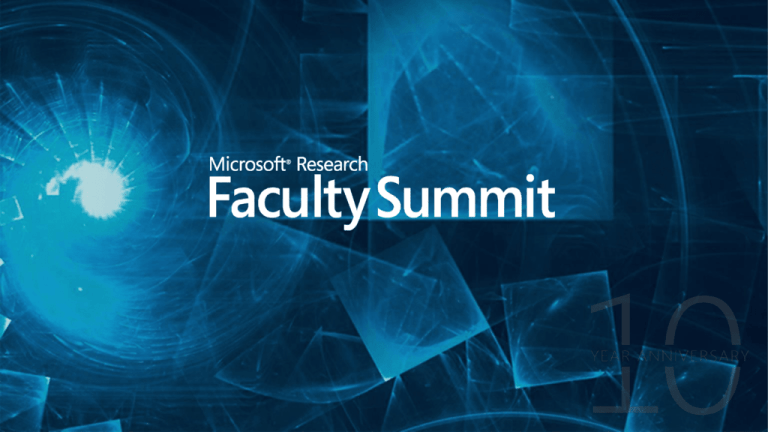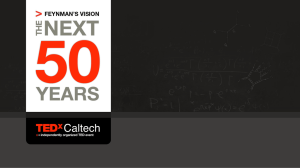
1918 Nobel Prize-winning physicist Richard Feynman
born in Far Rockaway on the outskirts of New York.
1939 Bachelor’s degree in physics, MIT.
1942 Ph.D. degree in physics, Princeton University.
1939-1946 Worked on Manhattan at Los Alamos under
Robert Oppenheimer. He was in charge of a group
responsible for problems involving large-scale
computations to predict the behavior of neutrons in
atomic explosions.
1946-1951 Developed his own approach to quantum
electrodynamics (QED) at Cornell with a unique
diagrammatic approach – now called Feynman Diagrams
- to conceptualizing and calculating interactions between
particles in space-time.
1951-1988 With fellow Nobel Prize winner, Murray GellMann at Caltech where he produced the famous
‘Feynman Lectures on Physics’
1965 Shared the Nobel Prize in physics for his role in
the development of the theory of quantum
electrodynamics, the study of the interaction of light with
atoms and their electrons.
1986 Member of the panel that investigated the Space
Shuttle Challenger disaster.
Physicist
Bongo drummer
Painter
Juggler
Safecracker
Prankster
Observed Tuvan national holidays
Research Councils UK
“I would drop everything to hear him lecture on the municipal
drainage system”
David Mermin, Cornell
“No matter how difficult the subject – from gravity through quantum
mechanics to relativity – the words are sharp and clear. No stuffed
shirt phrases, no ‘snow jobs’, no obfuscation”
Irving
Bengelsdorf, LA Times
“I shall include details of anecdotes which are of no value
scientifically nor for understanding the development of the ideas.
They are included only to make the lecture more entertaining”
Feynman in his Nobel Lecture
In quantum field theory a Feynman
diagram is an intuitive graphical
representation of a contribution to
the transition amplitude.
Each Feynman diagram represents
a term in a perturbative expansion
of the transition amplitude between
the initial and the final states of a
quantum system.
Antiparticles are represented as
particles going ‘backwards in time’!
In this Feynman diagram,
an electron and positron annihilate,
producing a virtual photon that becomes
a quark-antiquark pair.
Then one radiates a gluon.
The seven “Messenger Lectures” were
filmed at Cornell University and broadcast
by the BBC over a period from November
9th through November 19th, 1964
The ‘Microsoft Research Enhanced
Video Player’ adds a set of rich features
to augment the user’s experience when
viewing the lectures
Uses Microsoft Silverlight 2.0 web
streaming
“The stories in this book were collected
intermittently and informally during seven
years of very enjoyable drumming with
Richard Feynman. I have found each story
by itself to be amusing, and the collection
taken together to be amazing: That one
person could have so many wonderfully
crazy things happen to him in one life is
sometimes hard to believe. That one person
could invent so much innocent mischief in
one life is surely an inspiration! “
Ralph Leighton
AdvancedComputing andComputer ScienceMakesItPossible
Environment
To really make a difference we need to focus on research into the causes of environmental
change rather than just working on documenting the results and effects of climate change
Health
There are a lot of people working in the area of cell phones as a tool for Healthcare – every
country has an emerging sector with a need for healthcare solutions—even the richest
countries in the world.
Education and Scholarly Communications
Enhanced Video Player to improve the accessibility of complex topics
Scholarly Communication assets are exciting the academic community
Enthusiasm for using robotics to teach computer science principles
Digital Heritage / eHeritage
Important to preserve our cultural heritage
Design Expo
45 stickers, the next highest was 24
Authors:
Carnegie Mellon, Department of Design
Shelley Evenson, Bruce Hanington <> Monica Gonzales- Office
Design
Central Academy of Fine Arts, Media Lab, Beijing, China
Jun Fei <> Dave Vronay-ATC Beijang
Art Center College of Design, Pasadena, California
Karen Hoffman, Brian Boyl <> Craig Hally-XDR
Universidad Iberoamericana, Mexico Citye, Vin
Jorje Meza Aguilar, Ariel Mendez <> Andy Cargile, Vincent Ball
Dundee University, Scotland, UK
Graham Pullin, Jon Rogers <> Richard Banks-Microsoft
Research
New York University, Interactive Telecommunications
Program
Nancy Hechinger <> Lili Cheng, Microsoft Research
University of Washington, Interaction Design Division
Axel Roesler <> Georg Petschnigg-Pioneer Labs
15 stickers, the next highest was14
Author: Simon Mercer, Michael
Zyskowski, and Jared Jackson
Your comments and input are very, very important to us!
This year’s event reflects feedback from previous years:
More unscheduled time (deliberate reduction in lunchtime sessions)
Broad important theme topics to create appetite for cross disciplinary
discussion
Session on technical direction and strategy at Microsoft – a look inside how
challenges and technology combine to create product
What will happen next:
A NetReflector survey link will arrive in your inbox
There will be a range of questions, from how your flight was to your ratings
of the sessions that you attended
It won’t take long to complete: fewer than 10 minutes!
Addressing World-Scale Challenges
Computation as a powerful change
agent in areas such as Energy,
Environment, Healthcare, Education
Collaboration and Community
© 2009 Microsoft Corporation. All rights reserved. Microsoft, Windows, Windows Vista and other product names are or may be registered trademarks and/or trademarks in the U.S. and/or other countries. The information herein is for informational purposes only and represents the
current view of Microsoft Corporation as of the date of this presentation. Because Microsoft must respond to changing market conditions, it should not be interpreted to be a commitment on the part of Microsoft, and Microsoft cannot guarantee the accuracy of any information
provided after the date of this presentation. MICROSOFT MAKES NO WARRANTIES, EXPRESS, IMPLIED OR STATUTORY, AS TO THE INFORMATION IN THIS PRESENTATION.








